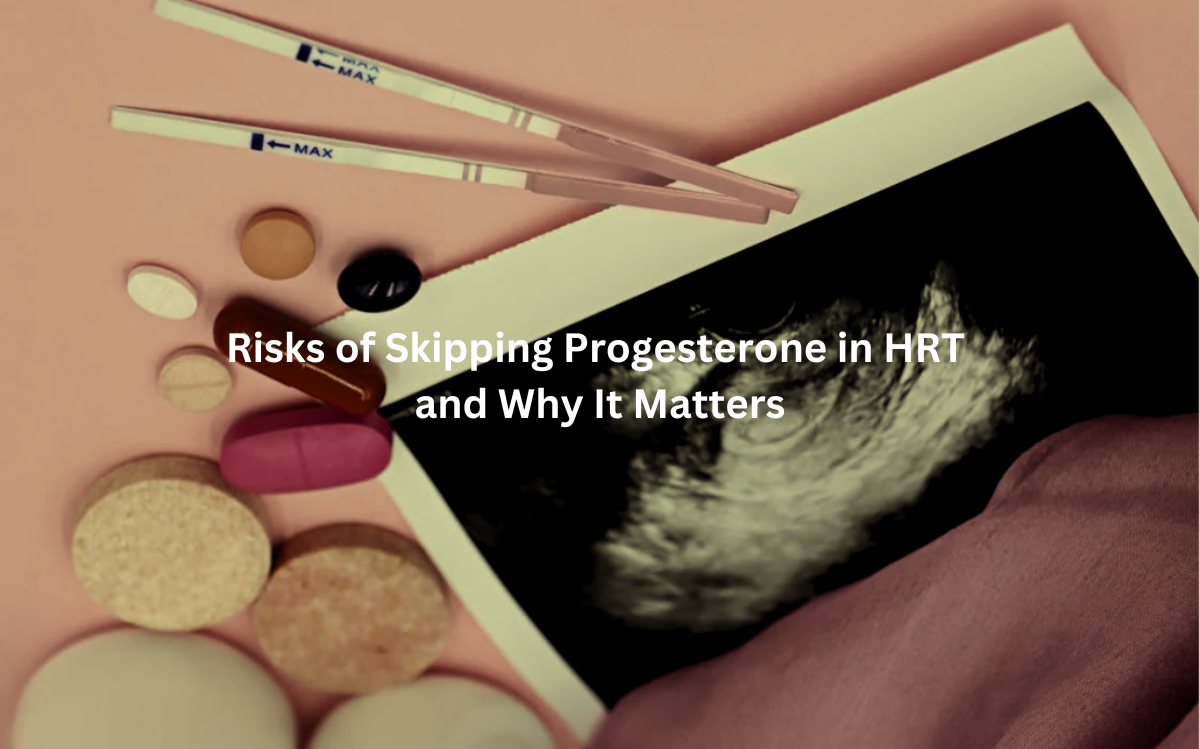Skipping progesterone in HRT can lead to serious health risks, especially for endometrial and heart health.
Skipping progesterone in hormone replacement therapy (HRT) can significantly increase health risks, particularly for women with a uterus. Progesterone is essential for balancing the effects of estrogen and protecting the endometrium. (1)
Without it, the risk of developing endometrial hyperplasia, uterine cancer, and even cardiovascular problems rises.
Key Takeaway
- Increased Risk of Endometrial Cancer: Skipping progesterone with estrogen-only therapy raises the risk of endometrial hyperplasia and cancer.
- Heart and Cardiovascular Risks: Unopposed estrogen therapy can elevate blood pressure and increase the likelihood of heart disease and blood clots.
- Importance of Progesterone in Symptom Management: Progesterone plays a crucial role in balancing hormones, reducing menopause symptoms, and preventing irregular bleeding.
Risks of Skipping Progesterone in HRT
When it comes to Hormone Replacement Therapy (HRT), progesterone plays a pivotal role. It’s an essential hormone for women who still have their uterus, as it helps balance the effects of estrogen.
Without progesterone, estrogen alone can wreak havoc on the lining of the uterus, leading to conditions like endometrial hyperplasia. Simply put, skipping progesterone is a risky move that could lead to serious health issues.
Progesterone, in combination with estrogen, reduces the risk of endometrial cancer. Without it, the uterus might get too thick, and the risk of cancer increases significantly.
Women who don’t use progesterone in their HRT regimen face a higher chance of abnormal cell growth in the uterine lining. That’s not a risk anyone should take lightly, especially when the consequences could be as severe as cancer.
Impact of Skipping Progesterone on Endometrial Health
Skipping progesterone is a bigger deal than it seems. Without progesterone, the inner lining of the uterus – the endometrium – can thicken dangerously. This thickening, known as endometrial hyperplasia, can set the stage for more serious issues, like uterine cancer.
Here’s what happens:
- Estrogen causes thickening: Unopposed estrogen leads to the endometrium growing too much.
- Increased cancer risk: The longer estrogen is used without progesterone, the higher the risk of cancer.
- Need for monitoring: Regular hormone checks are crucial. Adjustments help keep estrogen and progesterone in balance.
Skipping progesterone isn’t just missing a hormone; it’s risking long-term health. It’s easy to overlook, but these risks aren’t worth ignoring. Women should talk to their doctors about hormone levels and make sure their balance stays on track. It’s a small thing that can make a big difference.
Potential Side Effects of Skipping Progesterone
Skipping progesterone can also lead to a range of side effects, some of which are more immediate than the long-term risks like cancer. (2)
One of the most concerning is the increased likelihood of blood clots. Estrogen, when taken alone, has been linked to an elevated risk of clot formation, which can lead to serious issues like heart attacks or strokes. For women already at risk for cardiovascular problems, this is a particularly worrying side effect.
In addition to blood clots, skipping progesterone might cause an increase in blood pressure. Over time, this could escalate into more severe cardiovascular issues, further raising the risk of heart disease. Hormones play a critical role in regulating the cardiovascular system, and imbalances caused by skipping progesterone can tip the scale in the wrong direction.
Irregular bleeding or unexpected vaginal bleeding is another potential side effect. The uterine lining may begin to shed unevenly, causing spotting or heavier periods. This not only disrupts normal life but also signals that something is off with the hormone balance.
Combined HRT vs. Estrogen-Only Therapy

There are two primary types of HRT: combined HRT and estrogen-only therapy. The key difference? Combined HRT includes both estrogen and progesterone, while estrogen-only therapy relies solely on estrogen. For women who still have a uterus, combined HRT is essential. Estrogen-only therapy is typically only recommended for women who’ve had a hysterectomy.
The risk of breast cancer is one of the most significant concerns when considering combined HRT. Prolonged use of combined HRT has been shown to slightly increase the risk of developing breast cancer, especially after several years of use. However, this risk is far less concerning than the risk of endometrial cancer when progesterone is not included.
For women with a uterus, it’s clear that the combined approach (estrogen and progesterone) is the safer option. It balances the benefits of estrogen while minimizing the risks associated with unopposed estrogen.
Cancer Risks and Hormone Replacement Therapy
Hormone replacement therapy (HRT) and cancer? It’s a tricky relationship. The choice to skip progesterone can raise the risk of endometrial cancer. Adding it? That might nudge breast cancer risk up slightly for women on combined HRT, especially after prolonged use.
Here’s what makes a difference:
- Dose matters: Lower hormone levels often mean fewer risks.
- Form matters too: Switching to transdermal estrogen (like patches) may reduce risks of blood clots and heart issues.
- Timing is key: Adjusting the regimen over time is crucial.
Studies suggest that careful management can reduce these risks significantly. No one-size-fits-all here—it’s about personalised care. Women (especially those with family cancer histories) should regularly discuss benefits versus risks with their healthcare providers.
Proactive monitoring? That’s the sweet spot. Adjust hormone levels, stay aware, and ensure treatments match your body’s needs.
Managing Symptoms of Menopause Without Progesterone
For women who cannot or choose not to use progesterone, there are alternative options for managing menopause symptoms. Hot flashes, night sweats, and mood swings are the most common issues women face during menopause, and many turn to HRT to alleviate these symptoms.
For those unable to use progesterone, there are non-hormonal therapies to explore. Medications like SSRIs and gabapentin have been shown to help manage hot flashes and mood swings, though they aren’t as effective as estrogen therapy. Cognitive Behavioral Therapy (CBT) is another useful option for addressing mood swings and anxiety, providing a holistic approach to managing menopause.
Natural alternatives, including herbal supplements like black cohosh and soy, might also offer some relief. However, these should be used with caution, as the evidence supporting their effectiveness is mixed. Always consult a healthcare provider before opting for these options to ensure they’re safe and effective.
Role of Healthcare Providers in Managing HRT Risks
Managing HRT risks is a team effort. Women need to work hand-in-hand with their healthcare providers. Doctors should assess risks, like cardiovascular issues or cancer, to find the right hormone dosage.
Here’s how they can help:
- Monitor hormone levels: Adjustments may be needed, especially if something’s off.
- Frequent check-ups: If there’s a family history of cancer, more visits might be required.
- Referrals: Women with complex health backgrounds (heart disease, cancer history) could benefit from seeing a menopause specialist.
Personalised care—nothing beats it. Providers need to keep close tabs on treatment to minimise risks and maximise the benefits. For example, a woman with a history of blood clots might need lower doses or a different method.
It’s all about adapting the plan as the body changes. Keep the conversation open with doctors and adjust things as necessary.
HRT and Risk of Heart Disease
Hormone replacement therapy has implications for heart health. Some studies have shown that skipping progesterone and using estrogen alone can increase the risk of cardiovascular issues. This is especially true for women who have other risk factors for heart disease, like high blood pressure or diabetes.
Interestingly, using transdermal estrogen (administered through a patch or gel) has been shown to carry a lower risk of heart disease compared to oral estrogen. This is because transdermal estrogen bypasses the liver, which can help avoid some of the negative cardiovascular effects associated with oral estrogen.
Lifestyle changes, such as eating a healthy diet, exercising regularly, and avoiding smoking, play a critical role in supporting heart health during menopause. These changes, in combination with the right hormone therapy, can help keep the heart healthy and reduce the risk of disease.
Conclusion
Skipping progesterone in HRT is not a decision to be taken lightly. It poses serious risks, particularly in terms of endometrial health, cardiovascular health, and cancer.
Women who still have their uterus should be especially cautious, as progesterone is crucial for protecting the uterus from the harmful effects of estrogen. Regular monitoring and working closely with healthcare providers to adjust hormone therapy as needed are key to minimizing these risks.
While there are alternatives for managing menopause symptoms without progesterone, it’s important for women to fully understand the potential risks and benefits of each option.
Ultimately, the best approach is personalized care, ensuring that each woman’s treatment plan is suited to her specific needs, health history, and preferences.
For expert advice on HRT options, book your consultation with Modern Menopause today. Book now.
FAQ
What are the risks of skipping progesterone in HRT regimens?
Skipping progesterone in combined hormone replacement therapy (HRT) can increase the risk of endometrial cancer, especially when using estrogen-only therapy for an extended period.
Long-term use of estrogen without progesterone raises concerns about bone loss and higher risks of uterine hyperplasia. For menopausal women, a balanced progesterone dose is essential for protecting the uterus and reducing risks associated with skipped progesterone.
How does skipping progesterone affect women’s health?
Skipping progesterone can increase the risk of uterine cancer, as unopposed estrogen can lead to abnormal growth of the endometrial lining. Additionally, women receiving combined oral therapy or those on low-dose estrogen may experience irregular bleeding patterns or increased risk of osteoporosis and cardiovascular issues if progesterone is missed over time.
Can skipping progesterone lead to heart attacks or strokes?
Yes, skipping progesterone in HRT regimens may contribute to increased risks of heart attack and stroke, especially when combined with higher doses of estrogen. Long-term use of estrogen without progesterone can elevate the risk of coronary heart disease and other cardiovascular issues. For women aged 50-60, carefully considering the type of HRT and adjusting progesterone intake can help reduce these risks.
What happens to bone health if progesterone is skipped?
Skipping progesterone in HRT can lead to higher risks of bone loss, particularly in women who are on long-term estrogen-only therapy. Progesterone helps to counteract the bone-depleting effects of estrogen, ensuring that bone density remains stable. Missing progesterone increases the likelihood of osteoporosis and related fractures in menopausal women.
Does skipping progesterone affect the menstrual cycle?
Yes, skipping progesterone can disrupt the normal menstrual cycle, especially for women in perimenopause or those starting HRT. The lack of progesterone may lead to irregular bleeding patterns or more intense vaginal dryness, impacting the overall quality of life. Regular use of progesterone helps maintain hormonal balance and manage symptoms like these.
How does skipping progesterone affect estrogen therapy?
Skipping progesterone while using estrogen therapy can lead to an increased risk of endometrial cancer and irregular bleeding. While estrogen alone is effective for managing menopausal symptoms, combining it with progesterone protects the uterus and reduces risks like cancer and bone loss. Using the lowest effective dose of progesterone can help maintain the benefits of estrogen therapy safely.
How does skipping progesterone impact the risks of HRT?
Skipping progesterone can exacerbate the risks of HRT, including a higher likelihood of uterine cancer, heart attack, stroke, and bone loss. It is crucial for women to follow a balanced regimen that includes both estrogen and progesterone to manage the risks of HRT effectively. Adjusting the type of HRT based on individual needs can help reduce these risks over time.
Is skipping progesterone safe for menopausal women?
Skipping progesterone in menopausal women on HRT is not recommended as it increases the risks of adverse effects like uterine cancer, cardiovascular disease, and osteoporosis. For women with a history of liver disease, heart attack, or other complications, it’s essential to follow an individualized HRT regimen with both estrogen and progesterone to minimize health risks.

Leave a Reply